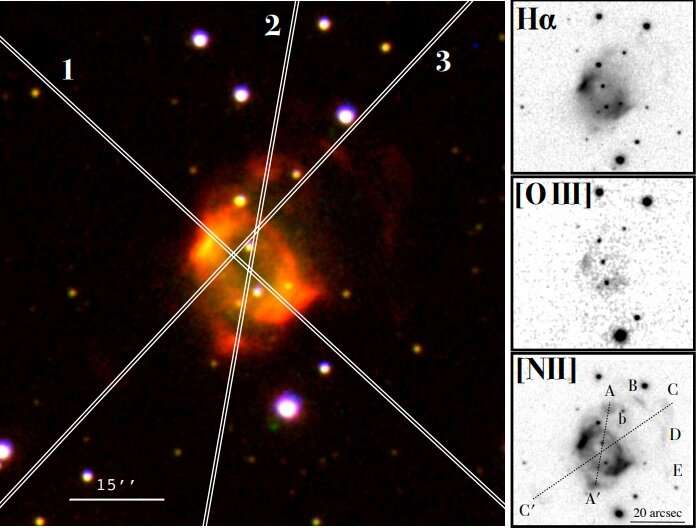October 5, 2020 report
Planetary nebula IPHASX J191104.8+060845 explored in detail

An international team of astronomers has investigated a bipolar planetary nebula designated IPHASX J191104.8+060845. Results of the new study provide essential information about the morphology and physical properties of this object. The research is detailed in a paper published September 23 on arXiv.org.
Planetary nebulae (PNe) are expanding shells of gas and dust that have been ejected from a star during the process of its evolution from a main sequence star into a red giant or white dwarf. They are relatively rare, but are important for astronomers studying the chemical evolution of stars and galaxies.
The Isaac Newton Telescope Photometric H-Alpha Survey (IPHAS) is a major survey of the northern galactic plane, carried out with the 2.5-meter Isaac Newton Telescope (INT) in La Palma, Spain. The survey is excellent for the detection of extended evolved planetary nebulae at the faint end of the PNe luminosity function. To date, IPHAS has identified more than 150 potential PNe exhibiting different types of morphologies.
IPHASX J191104.8+060845 (J191104 for short) is a PN identified by IPHAS and confirmed by Gran Telescopio de Canarias (GTC). A group of astronomers led by Janis Berenice Rodríguez-González of the National Autonomous University of Mexico conducted follow-up observations of this PN in June 2018 to characterize its nature, morphology and physical properties. For this purpose, they employed the Nordic Optical Telescope (NOT) in La Palma, Spain.
When it comes to the morphology and structure of J191104, the NOT images show a main cavity with two extended low-surface-brightness lobes located toward the northwest and southwest directions. The researchers found that the PN has a bright central elliptical structure surrounding the main cavity, encircled by detached patches of emission of ionized nitrogen and doubly ionized oxygen.
The distance to J191104 was estimated at around 16,000 light years and it has a kinematical age of about 11,000 years. The effective temperature of this PN was measured to be approximately 8,000 K, while its electron density is at a level of 200 cm-3. The astronomers found that J191104 is rich in helium, oxygen and nitrogen.
The GTC spectra suggest that J191104 is a Peimbert Type I source, given its high nitrogen and helium abundances, filamentary structures, and low mean scale heights above the galactic plane. According to the astronomers, this means that J191104 has been formed by the evolution of a massive progenitor star, very likely more massive than 2.4 solar masses.
All in all, the authors of the paper concluded that J191104 is an old, evolved, heavily reddened and extinct PN. The results indicate that dust has survived the evolution of the PN's central for 11,000 years.
"This means that the barrel-like structure might have been dense enough to shield dust from the UV flux. Another possibility is that dust has recently formed due to the reduction of the ionizing photon flux from the progenitor star," the researchers explained.
More information: Rodríguez-González et al., Detailed studies of IPHAS sources—III. The highly extinguished bipolar planetary nebula IPHASX J191104.8+060845. arXiv:2009.11164 [astro-ph.SR] arxiv.org/abs/2009.11164
Provided by Science X Network
© 2020 Science X Network





















